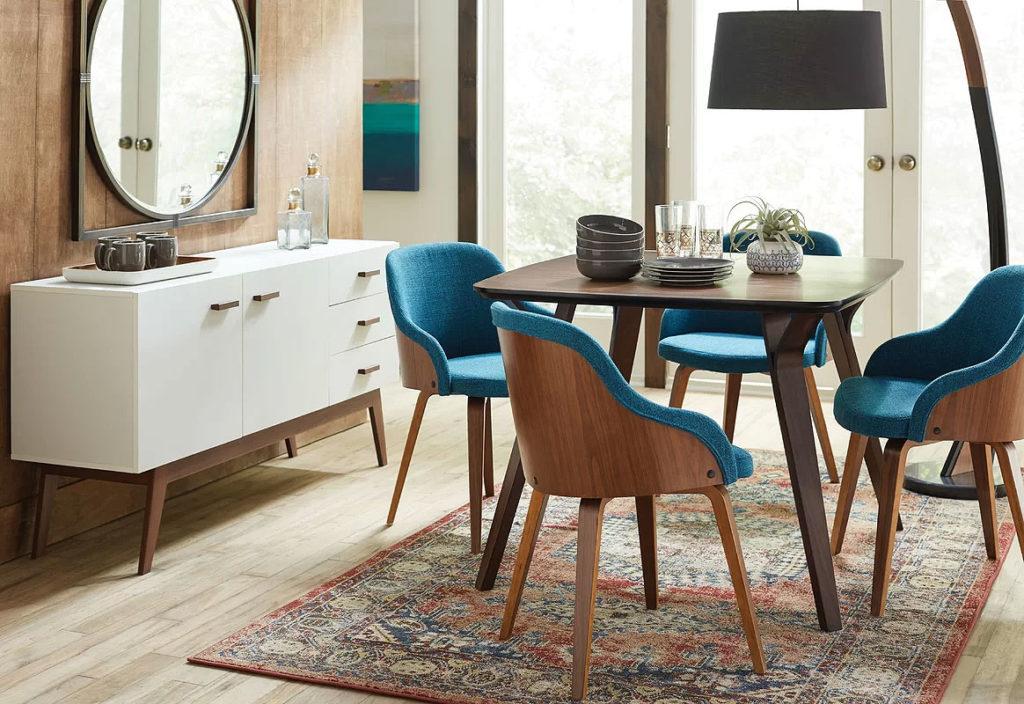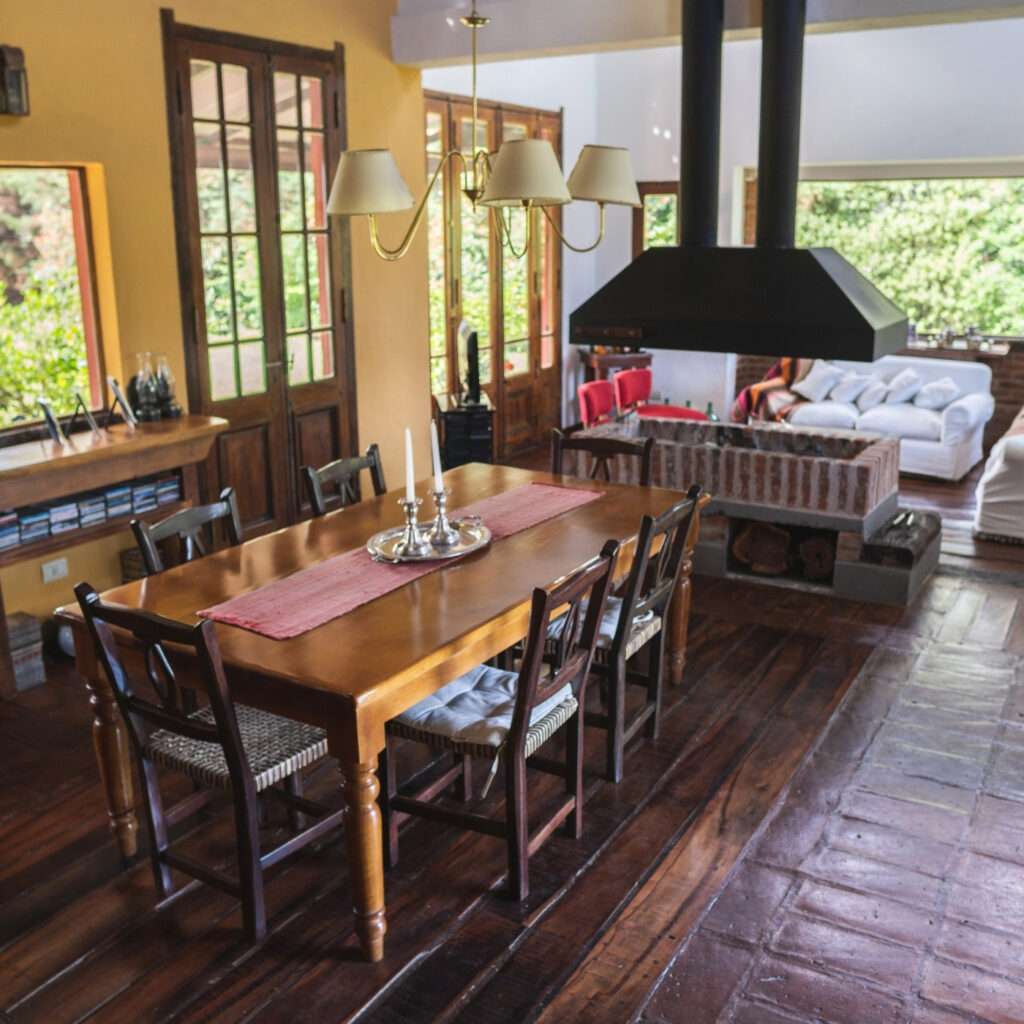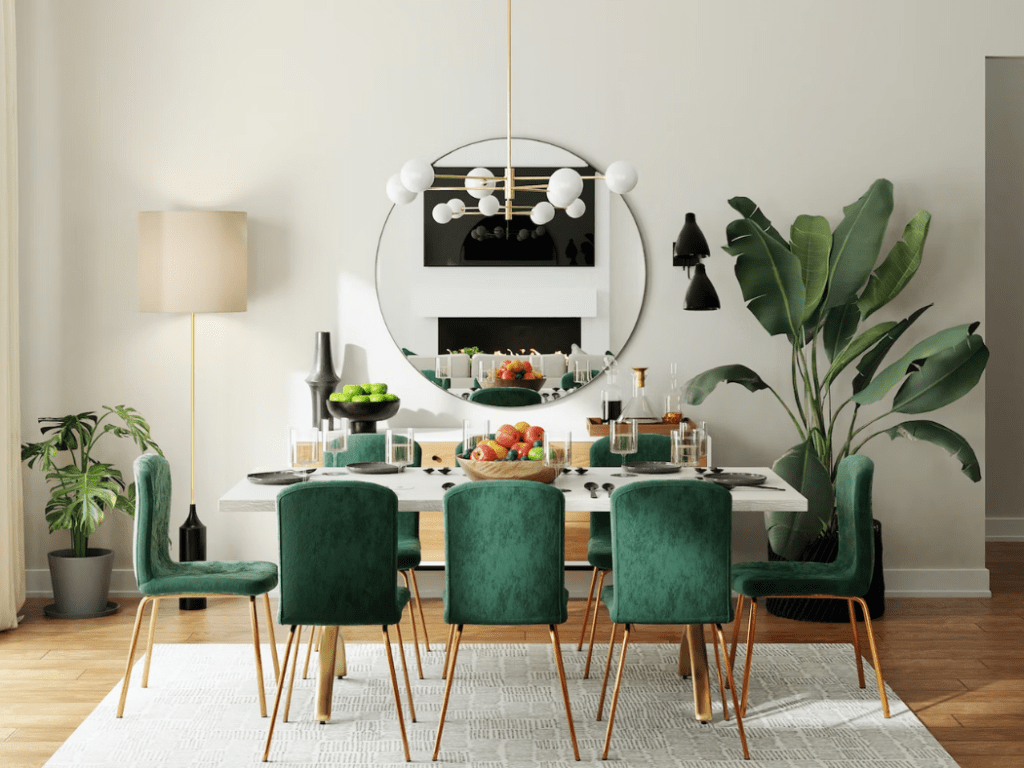Looking for a fresh take on dining space decor? This in-depth guide offers practical tips and unique ideas to elevate your dining room or nook. Whether you’re a decor novice or a seasoned pro, find inspiration for your next project here.
The dining room: it’s where stories get shared, laughter echoes, and memories are made. But let’s face it, those moments are far more enjoyable in a space that reflects personal style and invites a sense of well-being. Enter the realm of dining room ideas and decorating strategies designed to elevate this essential area from merely functional to fabulous. While some might have the luxury of a formal dining room, others craft a cozy nook for their culinary adventures. Whether the aim is to imbue elegance or spark a touch of chic flair, the forthcoming tips serve as a roadmap to revitalize any dining area.
The allure of a well-decorated dining space lies not just in its beauty, but in its capacity to serve as a canvas for life’s moments. And guess what? Creating such a space doesn’t require a degree in interior design or a pocketful of gold. The beauty of room decor lies in the details, and even simple changes can make a monumental impact. So, stick around; this isn’t your run-of-the-mill list of decorating ideas. It’s a curated collection of practical, accessible insights that make the process of decorating as satisfying as the end result.
Dining areas, whether stand-alone or open-plan, should be functional, practical, and beautiful. This is a place for family dinners, dining parties, or homework, making it a potentially most frequented room in your home. That said, your dining space, whether modern, farmhouse, or formal, deserves some glam and styling.
The decision to decorate your dining space doesn’t come easy. Most homeowners prioritize their kitchens, bathrooms, and bedrooms. Stay tuned for a delightful journey that promises an aesthetic boost to the dining area, without burning a hole in the pocket or eating up weekends. After all, the goal is not just a visual feast but also an effortlessly enjoyable experience.

Section 1: Assessing Your Dining Space
Before diving into paint swatches and Pinterest boards, it’s imperative to take a step back and assess the dining area. Knowing what you’re working with is the first step in any successful decorating endeavor. This section will explore why understanding the space is crucial, how to measure dimensions and layout effectively, and the distinct options available for a formal dining room or a more casual nook. Understanding these elements sets the stage for decorating decisions that are both aesthetically pleasing and functionally sound.
Why It’s Crucial to Know Your Space
In the decorating world, knowledge isn’t just power; it’s the cornerstone of creating a space that feels both cozy and practical. Assessing the area provides the necessary context for every decorating decision to come. A hasty choice, like a dining table that’s too large, can throw off the balance and flow of the space. A room that feels cramped or impractical takes away from the pleasure of dining and socializing. That’s why the first step in any decorating project is to arm oneself with a tape measure and a clear sense of the room’s purpose.
Understanding Dimensions and Layout
Size does matter, at least when it comes to decorating a dining area. The dimensions dictate what furniture can fit and how to optimize the room for flow and function. Start by measuring the length, width, and even the height of the room—don’t forget to account for things like windows, outlets, and built-in features that might influence where furniture can go. Mapping out a rough floor plan—even a doodle on a napkin—helps visualize the layout, and there are also plenty of apps designed to assist in this planning phase.
Formal Dining Room vs. Casual Nook
The atmosphere of the dining space greatly impacts how it gets used. Formal dining rooms often conjure images of grand tables, elegant lighting, and perhaps a sense of rigidity. These rooms are fantastic for dinners that are more on the ceremonial side—think holidays and milestone celebrations. On the flip side, a casual nook is perfect for everyday meals and doubles up as a versatile space for other activities, like homework or casual get-togethers. The choice between formality and casualness is not merely stylistic but also influences the types of furniture, decor, and even lighting that will work best.
Section 2: Defining Your Style
After assessing the space, the next logical yet exciting step is defining the style for the dining room. Imagine walking into a room that feels like a visual autobiography. That’s the magic a well-defined style can achieve. This section will guide through the process of identifying individual tastes—be it trendy, classic, or eclectic—while also discussing how to use decor to reflect personality and how color choices set the room’s mood.
Trendy, Classic, or Eclectic: What’s Your Flavor?
From rustic wooden dining chairs to wallpaper featuring the boldest pattern, the best dining room decor starts with a clear style direction. Trendy designs might feature a pendant light sourced straight from an Elle Decor feature, offering a pop of modernity. Classic dining room design might veer toward elegant dining chairs and a rich wooden dining room table, perhaps complemented by a traditional sideboard. The eclectic soul might go for a gallery wall featuring an assortment of art that speaks volumes about their varied interests. By recognizing the overarching style, all future dining room decor ideas fall into place like pieces of a jigsaw puzzle.
Using Decor to Reflect Personality
Ever enter a room and think, “Wow, this is so them?” That’s the power of home decor that reflects personality. Dining room decorating ideas don’t have to come exclusively from interior designer magazines. They can be an extension of individual quirks and preferences. Love to travel? How about incorporating some global pieces into the dining room space. An aficionado of modern art? A splash of abstract could bring the room to life. From the dining chairs selected to the type of pendant light that illuminates the room table, each element is a chapter in the story that the dining area tells about its inhabitants.
Setting the Mood: Color Choices and Their Impact
Colors are not just hues on the wall; they’re mood-setters. An airy blue could evoke a sense of calm, while a bold red might energize the space. Elle Decor and other interior design platforms often showcase how the color of a dining room can dramatically affect its overall vibe. A small space can appear more expansive with lighter colors, while dark hues can add a sense of grandiosity to even the most modest dining areas. Whether opting for wallpaper, a gallery wall, or a single solid hue, the color becomes the backdrop against which all other elements—from rustic elements to elegant dining room features—come to life.
So, the journey to a well-styled dining room doesn’t need to be a shot in the dark. With a clear style, a touch of personality, and the right color scheme, any dining area can transition from a simple eating spot to a cherished gathering place. Just remember, every piece of furniture, from dining chairs to the room table, is an opportunity to make a style statement that is distinctly yours.
Section 3: The Building Blocks of a Dining Room
Constructing a dining space that makes a statement and serves its function isn’t rocket science, but it does require some careful thought. Imagine the dining room as a stage where each piece of furniture and decor plays a crucial role in the overall performance. This section breaks down the essential furniture pieces, offers guidelines on selecting the right table and chairs, and reminds everyone not to overlook the importance of tableware.
Essential Dining Room Furniture Pieces and Their Roles
Let’s kick things off by discussing the main cast—the furniture. At center stage, there’s usually a dining table and chairs. These are not just places to sit and eat; they set the entire tone for the room. Whether choosing warm wood dining table options for a rustic look or a glass-top table for a modern touch, the table is essentially the heart of the dining room. Complementing it is a set of dining chairs that can either match or contrast, depending on the style dining one is going for.
But let’s not forget the supporting cast. Wall paneling can give the room a cottage dining room feel or elevate a more formal space. A sideboard or buffet is not just practical for storage but also provides an additional surface for decor or food when hosting. Each of these pieces contributes to making the dining room feel complete and functional.
How to Choose the Right Table and Chairs
Choosing the right dining table and chairs isn’t just about dimensions; it’s also about how they integrate into the overall room decor. Warm wood options make a space feel cozy, while metal or glass selections can offer a more modern touch. If the aim is to create a spacious dining room, lighter colors and slender furniture profiles help.
Then comes the question of chairs. Rattan for a relaxed, boho feel? Upholstered for a touch of luxury? Or maybe a mix-and-match approach that’s sure to impress guests and spark conversation? The chairs should not only be comfortable for everyday dining but also in line with the overall aesthetic of the room. Ideas will help here, but the choice ultimately depends on individual taste and the existing room decor.
Don’t Forget About the Tableware
While it might not be a piece of furniture, tableware is an unsung hero in dining rooms. Whether you prefer a pop of color from patterned plates or the timeless elegance of neutral dining sets, the right tableware enhances the dining experience. Even simple additions like a stunning tablecloth can transform the space feel and make your dining room the perfect backdrop for everything from weeknight dinners to holiday feasts.
So, there it is. From the furniture that serves as the foundational elements to the tableware that adds the finishing touches, every element in a dining room has its role. The key is to integrate these elements in a way that feels cohesive, functional, and, of course, stylish. After all, dining rooms are the perfect setting for creating memories, whether it’s a casual family dinner or a festive gathering that’s sure to impress.

6 Simple Tips for Decorating Your Dining Space
A dining room doesn’t need a complete overhaul to feel refreshed and renewed. Sometimes, all it takes is a few simple touches to elevate the space into something extraordinary. This section dives into three simple yet impactful tips that transform a dining area without requiring a sledgehammer or a second mortgage.
Consider the Ceiling
Often, the ceiling gets neglected in room decor. However, it’s essentially the fifth wall and offers an array of opportunities to elevate a dining space. A simple coat of paint in a color that contrasts with the walls can create a stunning visual effect. For those who are a bit more daring, consider installing a decorative ceiling medallion or even some tasteful wallpaper. It’s like adding a cherry on top of an already delectable sundae, making the dining room feel complete from top to bottom.
Stick With the Purpose of the Dining Space
The primary purpose of your dining space should guide your decoration. Dining spaces mostly accommodate other household purposes besides eating meals. For instance, if you live in a one-bedroom apartment or studio home, you can create a small dining space that doubles up as a workspace for your kids’ homework or home office.
Most people also use their dining rooms to host dinner parties or organize a banquette. That said, you should consider the functionalities of this space before starting the decorations.
Use Mirrors to Amplify Space and Light
Mirrors are like the Swiss Army knife of home decor—versatile, practical, and always good to have around. Placing a large, stylish mirror on one wall not only gives the illusion of a more expansive room but also reflects light to make the space brighter. It’s an especially useful trick for dining rooms that might be on the smaller side or lack natural light. And hey, it also provides a quick way to check for spinach between teeth before leaving the room.
Pick a Cohesive Theme for Your Dining Space
Having a clear purpose makes it easy to choose the theme of your dining space for remodeling. You can choose the best theme that suits your personality or explore other options from the various choices available. Common themes for dining room redesign include:
- Modern dining room: Features accent walls, inspiring wall décor, furniture with clean edges, and other modern aspects of design. You can choose various modern dining room furniture designs
- Farmhouse dining room: Mostly associated with natural colors and wide furniture pieces.
- Minimalistic dining rooms: Simplistic dining spaces with an easy flow in the dining area. Also features minimal furniture and decorations.
- Convertible dining space: Mostly for small or tiny homes. They double up as study rooms, reading corners, or home offices and often take advantage of multi-purpose furniture.
- Banquet halls: Best for luxurious homes with enough space. They are formal dining spaces designed for everyday meals and to accommodate guests. Such dining spaces feature exquisite wall art, centerpieces, chandeliers, and other flashy installations.
Note that the theme largely influences the layout of your dining space. Most dining rooms have rectangular floor space. However, you can opt for an open floor plan that conflates the dining space with your living room or the kitchen. If you prefer a closed dining space, though not common, it should be off the kitchen or between the kitchen and living room for easy access.
Infuse Some Greenery
A bit of green goes a long way in making a room feel vibrant and lively. Whether it’s a potted plant on a windowsill, a small herb garden on a shelf, or even some low-maintenance succulents, plants bring a touch of nature indoors. They’re more than just eye candy; they also improve air quality and can even boost mood. Not to mention, they make for great talking points during those slightly awkward dinner parties.
Install Appropriate Lighting Fixtures
Lighting is an important feature in modern interior designs. Your dining space should have sufficient and appropriate lights and lighting installation. Minimal lighting is enough for small dining rooms. However, large banquet halls require overhead lighting or LED lights. While at it, ensure that your lighting aligns with the theme of your dining space.
You should opt for lights with decorative sconces. Crystal chandeliers and other decorative lights work wonders and add character to small and large dining rooms. That aside, don’t forget to incorporate natural light, either through large windows or skylights.

Wrapping It Up: Crafting Your Ideal Dining Space
From the first brush of wall paint to the final placement of gold accents, creating a stunning dining room is an artistic endeavor in its own right. Maybe it’s adding a DIY wall of floor-to-ceiling white shiplap walls that makes it feel like a cozy escape, or perhaps it’s repurposing an unused corner into a chic nook, outfitted with warm wood tones and a globe pendant light. The sky’s the limit.
Incorporating elements like midcentury modern chairs and table into dining space decor can add an unexpected twist while keeping the palette neutral and calming. Those keen on quality and craftsmanship may find themselves drawn to details like intricate wall panels that match the walls and ceiling or a unique set of dining chairs to create a one-of-a-kind setting. A tip from designer Lauren Liess suggests adding pops of colors and finishes to create a serene yet lively atmosphere.
Remember, even the most sophisticated dining spaces have something in common: they keep the table clean! A simple wipe of the surface post-meal ensures that the room remains as attractive as the meal itself.
It’s not just about filling a room with furniture and decor; it’s about layering textures, colors, and styles to create a unique environment where memories can be made. Whether it’s a room with a large dining table to host family gatherings or a more intimate setting for everyday meals, there’s no one-size-fits-all approach. The only constant is the joy that comes from sitting down in a space that feels perfectly tailored to your tastes and needs.


As a realtor, I appreciate these practical tips for revamping dining spaces. Elevating the dining experience adds significant value to homes. Thanks for the insightful advice!
Make sure to vary the sizes of patterns and textures to create a harmonious balance. This will prevent the space from feeling overwhelming and ensure a visually pleasing result.